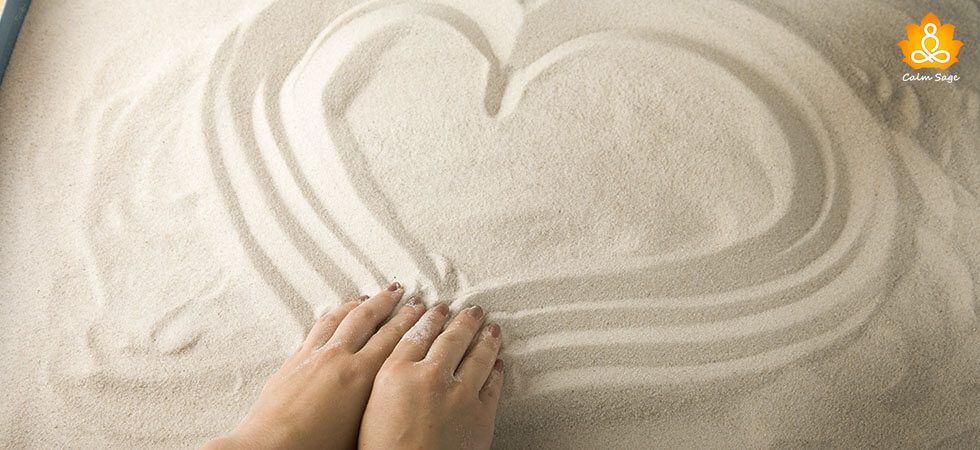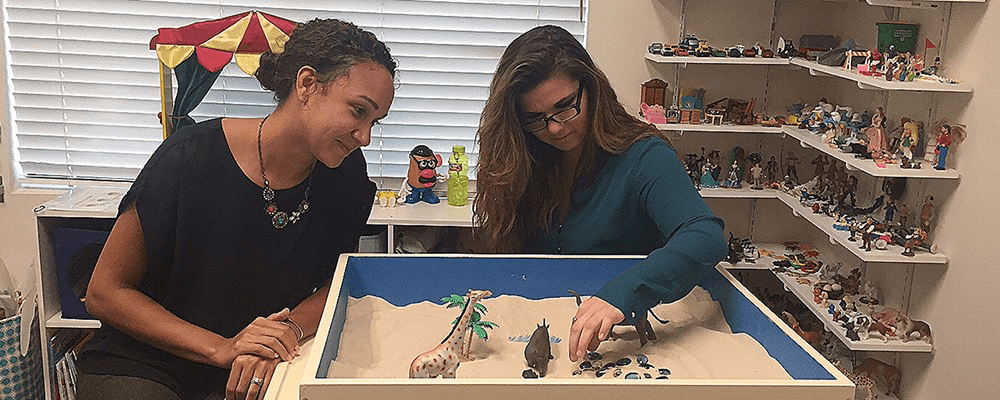Sand Tray Therapy: What Is It & How It Helps Heal Trauma

Sand Tray Therapy or Sand Play Therapy is used by those people who have suffered a traumatic event that left a negative impact on their mental health. Sand Tray therapy is often used by children but it is also applicable for teens and adults who have gone through physical abuse, sexual abuse, or any other tragic incident.

Image source: sscc.center
It can be better defined as expressive therapy where therapists let the patient work on the sand tray and meanwhile assess the thoughts and expressions to find out the reasons for distress.
What Happens In Sand Tray Therapy?
A combination of Art therapy and Play therapy, Sand Tray therapy lets an individual figure out a solution to their problems when they play using the sandbox. The therapist provides a sand tray box to the patient which also acts as a healing tool. Now the patient creates his own world in the sand while using miniature toys like cars, animals, trees, people, home, buildings, etc.
As the individual makes his own world by selecting any toy that he or she likes, therapists don’t interrupt the game and act as an active observer. Therapists believe that the way an individual draws out the scenario during the Sand Tray therapy denotes what is going inside him. Later when the discussion begins, the actions of the patient are noticed.
It is believed that the Sand Tray Therapy is capable of finding the answers that are hidden inside the person only while Talk therapy or Art therapy is introduced to find more solutions.
A Brief History Of Sand Therapy
Tracing the footsteps, Margaret Lowenfield (British Child Psychiatrist) is known to be the first person to try Sand Therapy. She explained that her idea of developing this therapy was inspired by the book ‘Floor Games’ written by H.G.Wells in which the author encourages his children to use play as means of personal development.
When she established her Institute of Child Psychology in London, she introduced two trays where one was filled with sand while the other with water and few other items. Now when children came in for treatment, they started developing their own world using a sandbox and it connected Margaret with the insight of a patient. She termed it as World Technique.
Later, Dora Klauff came to study the technique under Lowenfield and combined the study with Eastern Philosophy and Carl Jung’s theory of individualization. With this, Sand Play Therapy emerged and started acting as a therapy for many mental illnesses.
Where Sand Tray Therapy Is Used?
Sand therapy acts as a multidimensional form of therapy which allows a person to get comfortable and a sense of inner security takes place within them. Therapists apply it to generate emotional and mental stability within victims of physical abuse, neglect, sudden trauma or sexual abuse.
Kids, especially, are not able to express themselves and remain silent after the trauma, which is harmful for their mental stability. Sand therapy allows them to vent out their fear, anxiousness, and anger that later proceeds towards other healing processes.
Sand therapy is also applicable to adults as the safe environment during the therapist session lets them find comfort in expressing themselves to the doctor.
Debate On Sand Tray Therapy
Although there are multiple research studies and clinical trials which prove that Sand Tray Therapy is highly effective in providing non-verbal care and attachment to a person, some cultures found it time consuming and even frustrating. Usually, adults are less responsive to the therapy because they believe that artistic skills that are usually required for therapy are lacking in them.
It is also said that choosing the objects according to their mood and energy could be very vague for therapists to interpret it. Even then its efficiency is not ignored and is being applied in many cases around the world for treatment of trauma.
Wrap-Up
If you are looking for a Sand Tray therapist for your loved ones or your kids, talk to your doctor about it. Discuss your views and concerns with them and they will help you connect with the right therapist. You can also drop us a message at info@calmsage.com so that we can help you connect with a therapist with whom you can share your problems and get them resolved.
More Relavant Articles:
Gestalt Therapy: Why & How ‘Empty Chair Technique’ Is Used?
Therapy Guide: Understanding Therapists and Your Role in a Therapy





















After reading this post I have come to this conclusion that basically sand tray therapy is a mix of play and art.
Thank you for tell me about Sand Tray Therapy.
Sand therapy has always fascinated me! Thank you for this information.
This is the most creative and play therapy for numerous child and adult mental health problems